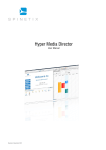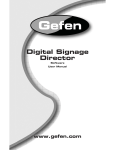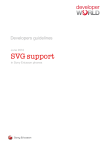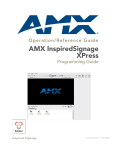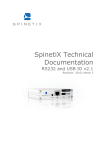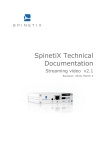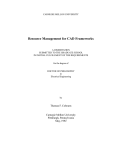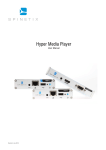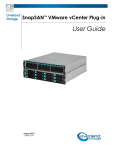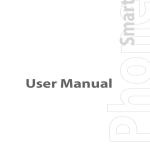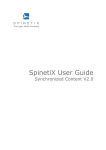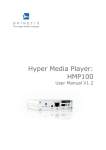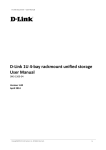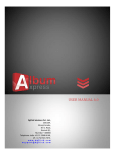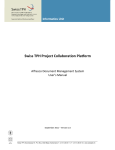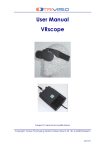Download Userguide HMD
Transcript
Hyper Media Director User Manual V1.1 © 2007-2008 SpinetiX S.A. All rights reserved. DISCLAIMER THE SPECIFICATIONS AND INFORMATION REGARDING THE PRODUCTS IN THIS MANUAL ARE SUBJECT TO CHANGE WITHOUT NOTICE. ALL STATEMENTS, INFORMATION, AND RECOMMENDATIONS IN THIS MANUAL ARE BELIEVED TO BE ACCURATE BUT ARE PRESENTED WITHOUT WARRANTY OF ANY KIND, EXPRESS OR IMPLIED. USERS MUST TAKE FULL RESPONSIBILITY FOR THEIR APPLICATION OF ANY PRODUCTS. THE SOFTWARE LICENSE AND LIMITED WARRANTY FOR THE ACCOMPANYING PRODUCT ARE SET FORTH IN THE INFORMATION PACKET THAT IS SHIPPED WITH THE PRODUCT AND ARE INCORPORATED HEREIN BY THIS REFERENCE. IF YOU ARE UNABLE TO LOCATE THE SOFTWARE LICENSE OR LIMITED WARRANTY, CONTACT YOUR SPINETIX REPRESENTATIVE FOR A COPY. NOTWITHSTANDING ANY OTHER WARRANTY HEREIN, ALL DOCUMENT FILES AND SOFTWARE OF THESE SUPPLIERS ARE PROVIDED “AS IS” WITH ALL FAULTS. SPINETIX DISCLAIMS ALL WARRANTIES, EXPRESSED OR IMPLIED, INCLUDING, WITHOUT LIMITATION, THOSE OF MERCHANTABILITY, FITNESS FOR A PARTICULAR PURPOSE AND NONINFRINGEMENT OR ARISING FROM A COURSE OF DEALING, USAGE, OR TRADE PRACTICE. IN NO EVENT SHALL SPINETIX OR ITS SUPPLIERS BE LIABLE FOR ANY INDIRECT, SPECIAL, CONSEQUENTIAL, OR INCIDENTAL DAMAGES, INCLUDING, WITHOUT LIMITATION, LOST PROFITS OR LOSS OR DAMAGE TO DATA ARISING OUT OF THE USE OR INABILITY TO USE THIS MANUAL, EVEN IF SPINETIX OR ITS SUPPLIERS HAVE BEEN ADVISED OF THE POSSIBILITY OF SUCH DAMAGES. Hyper Media Director User Manual V1.1 ©2007-2008 SpinetiX S.A. All rights reserved. "SpinetiX" and “HMP Hyper Media Player” are registered trademarks, and all logo and graphic designs are trademarks of SpinetiX S.A. Other product and company names appearing in SpinetiX S.A. products and materials are used for identification purposes only and may be trademarks or registered trademarks of their respective companies. Registered and unregistered trademarks used in any SpinetiX S.A. products and materials are the exclusive property of their respective owners SpinetiX S.A. EPFL PSE-C 1015 Lausanne Switzerland www.spinetix.com [email protected] Tel./Fax: +41 21 693 89 81 2 HMD User Manual V1.1 INTRODUCTION Hyper Media Director (HMD) is a software application developed by SpinetiX to simplify the implementation and the daily management of a digital signage project. It allows users to author, preview, schedule and publish hypermedia content on HMP devices. From hospitality to advertising, education and business communications, Hyper Media Director gives users a simple and general purpose interface to manage content on a single HMP device or a large, distributed network of several HMPs. In this manual we highlight five main features of Hyper Media Director: each is identified by a special icon that will help you navigate this document. Each feature is described by a set of chapters that focus on specific subjects. We are keeping adding new chapters explaining the multiple shortcuts and functionalities offered by HMD. Do not hesitate to discover yourself how to use this software: there are plenty of hidden shortcuts and drag and drop functions that are not yet documented in this manual but that appeared intuitive to us. We will keep adding more details to this manual, to its html version and to the technical forum that you can access on our web site: http://www.spinetix.com/forum Visit http://www.spinetix.com/downloadProjects to learn from real application examples what type of presentations you can author with HMD. Authoring Hyper Media content. This is a major feature of HMD that allows the end user to quickly learn how to compose a scene by combining backgrounds, logos, texts images and video clips. Scenes can then be added to playlist to compose entire presentations. The use of template documents simplifies the daily tasks and guarantees the respect of pre-defined graphical layout. Transitions effects can be added to each element to make the final presentation more live. Most authoring features are provided graphically and thus are very easy to learn: an advanced user can still edit the SVG document structure for a maximum control. Professional graphic designers can continue using the preferred authoring software to create art pieces and build a collection of icons, slides, graphics, animations, images, videos etc... Hyper Media Director will simplify the combination of all these medias onto the final canvas and presentation. Previewing Hyper Media content: Hyper Media Director integrates a real-time hyper media rendering engine featuring support for the SVG tiny 1.2 standard, SMIL and most video and image formats. The hyper media content can be interactively previewed to validate each authoring change before its publication. 3 © 2007-2008 SpinetiX S.A. All rights reserved. Scheduling Hyper Media projects: Hyper Media Director offers an intuitive and powerful interface to schedule the time when content shall be played by the target HMP device. Content can be scheduled at an exact time, or with specific periodicity. Support for multiple time zones is natively integrated so that you can schedule content across the world. Publishing Hyper Media projects: Hyper Media Director simplifies the publishing of media content on a specific HMP device or group of devices. You can decide which content will be displayed and when it will be displayed. Monitoring Hyper Media Players: Hyper Media Director simplifies the remote management of large network of HMP devices. You can automatically scan for devices installed on your network and monitor their individual status. 4 HMD User Manual V1.1 HOW TO GET HYPER MEDIA DIRECTOR Hyper Media Director is available for downloading from the SpinetiX Web site: http://www.spinetix.com/downloads Once downloaded on your personal computer (Windows OS: XP and Vista have been tested) you can install the software with a simple installation wizard. The first time you execute HMD, you are requested to activate the software. You have the following options: a) You simply wish to evaluate the product: click the 30-day trial button to benefit from HMD for 30 days. b) You have a valid license key to activate the software: click the Enter product key to register the software. As for today, SpinetiX is distributing in bundle with HMP100 units, special vouchers that allows getting a valid standard license to activate Hyper Media Director. This license activates all the authoring capabilities of HMD and is suitable to manage up to ten HMP100 units on the network. When a larger number of units need to be managed in a professional environment, additional publishing and monitoring functionalities are required. These can be activated by purchasing a valid professional license for HMD. Check our web store or send a message to [email protected] to receive more information on the professional license. At the end of this manual we report for your convenience the End-User Software License agreement that accompanies Hyper Media Director. 5 © 2007-2008 SpinetiX S.A. All rights reserved. TABLE OF CONTENT Disclaimer ............................................................................................................2 Introduction...........................................................................................................3 How to get Hyper Media Director..............................................................................5 Table of Content.....................................................................................................6 Introduction to the Graphical User Interface..............................................................8 Authoring............................................................................................................10 Introduction.....................................................................................................10 What can you do with Hyper Media Director authoring feature?...........................10 When to use Hyper Media Director authoring features?......................................10 Learning Hyper Media Director authoring features..............................................11 Hyper Media Projects.........................................................................................11 Browsing panel ................................................................................................12 Importing multi-media files................................................................................13 Importing images...........................................................................................13 Importing video.............................................................................................14 Importing PowerPoint presentation...................................................................14 Creating and Editing SVG files.............................................................................14 Create a new SVG document...........................................................................14 Edit an existing SVG document........................................................................15 Edit a media property.....................................................................................16 Interactive editing ............................................................................................18 More info on how to interactively edit SVG files..................................................19 Editing Media elements layout.........................................................................19 Editing Media links.........................................................................................20 Editing Text...................................................................................................21 Multi-layers SVG templates.................................................................................21 Composing a scene in 4 steps:........................................................................22 How to customize a multi-layer SVG document..................................................22 Example.......................................................................................................23 Playlist SVGX template.......................................................................................24 Composing a playlist SVGX document in 5 steps:...............................................24 How to customize a playlist SVGX document.....................................................25 Advanced playlist SVGX templates...................................................................27 Special News templates..................................................................................27 Scalable content and aspect ratio of your display..................................................30 Multimedia effects.............................................................................................33 Adding effects...............................................................................................33 Configuring effects.........................................................................................33 Previewing...........................................................................................................35 Preview a Hyper Media content...........................................................................35 The Coffee clipart as shown on the HMD:..........................................................36 The Coffee clipart as shown on the HMP100:.....................................................36 Publishing............................................................................................................37 Using manual publish.........................................................................................37 Using quick publish............................................................................................37 Publishing on network servers.............................................................................38 Manually add a Shared Project to HMD.............................................................38 Manually add WebDAV servers to HMD.............................................................40 Publishing on USB storage..................................................................................41 Monitoring...........................................................................................................43 Device Monitoring..............................................................................................43 Open a device...................................................................................................43 Automatically add devices to HMD.......................................................................44 6 HMD User Manual V1.1 Manually add a device to HMD............................................................................45 Check the status of the devices...........................................................................46 Scheduling...........................................................................................................48 Five quick steps to schedule the content displayed by a HMP100 unit...................48 Create a new schedule.......................................................................................49 Open a schedule...............................................................................................49 Add events to a schedule...................................................................................50 Modify the scheduling properties of an event........................................................51 Define default events and recurrences.................................................................51 Define a default animation..............................................................................51 Define recurring events..................................................................................51 Preview scheduled content.................................................................................52 SPINETIX End-User Software License Agreement......................................................54 7 © 2007-2008 SpinetiX S.A. All rights reserved. INTRODUCTION TO THE GRAPHICAL USER INTERFACE Hyper Media Director is designed to offer a simple graphical interface that provides easy access to all the supported key features: Content authoring, previewing, scheduling and publishing Device monitoring and management. The default view of the Graphical User Interface (GUI) is presented as: The Application Menu, at the top. Give access to the main functions of HMD. These functions are often redundant with shortcuts or mouse interactivity. The Preview panel, beneath the Menu. When you open a project (index.svg file) this window displays the hyper media content as it will appear on the HMP100. The advantage is that you can navigate across the project. The Browsing panel, beneath the Preview panel. The browsing panel can be used to browse local or remote locations. By default it opens the Workspace view (corresponding to the local path My Documents\Spinetix) which contains the following three folders: My Devices. Open this folder (double-click) to access the HMP100 devices installed on your network. This browsing area offer special function to automatically discover the installed units. Access these functions by rightclicking the browsing area. My Projects. Open this folder (double-click) to access the Hyper Media Projects area. In this area you can author the projects that you will publish on HMP100 devices. Access special functions through the pop-up menu that appears by right-clicking the browsing area. My Templates. Open this folder to discover the Hyper Media templates. Hyper Media Templates can be imported on your project to implement special animations or services (e.g. connect to an RSS feed and display the latest news...) Access special functions through the pop-up menu that appears by right-clicking the browsing area. The Editing panel, along the right side. This panel changes according to the content you have opened. It offers user friendly interfaces to customize the content and scheduling of your hyper media projects. The Status Bar, along the bottom. Used to notify what actions the HMD is currently executing. 8 HMD User Manual V1.1 The window size can be adapted to the size of your monitor. However, a minimum size has been imposed to guarantee a correct use of the interface. The size of the three panels in the interface can also be adapted: use the special handles between them to drag their relative dimension. The ergonomics of the interface are improved by the use of shortcuts and specialized dialog boxes. In the following sections we will refer to the elements of this GUI to illustrate how to use HMD to complete specific tasks. Hyper Media Director is application generic: it may not perfectly fit the needs of a specific digital signage user. We would like to preserve the generality of the application, but if you have suggestions to improve the ergonomics please send us your comments at [email protected]. 9 © 2007-2008 SpinetiX S.A. All rights reserved. AUTHORING Not yet another content authoring software! Introduction There are many well known commercial software solutions available to produce professional, native SVG media content (e.g. Adobe Illustrator, Corel Draw, Ikivo Animator), as well as excellent open source solutions such as InkScape which is available for free. These are ideal tools for the authoring of the graphical line of your application (templates, layout masks, custom animations...). Other popular software solutions to produce still image or animated media content for the HMP include Adobe Photoshop, Adobe Flash, GIMP (open source) and PowerPoint. The authoring feature of Hyper Media Director is not an alternative to these media authoring tools. Rather than reinventing the wheel, it is merely filling the gap between media elements and a digital signage application. Its purpose is to make it really easy to combine and customize media elements of different nature in order to build in a few clicks a digital signage content of professional quality. What can you do with Hyper Media Director authoring feature? Combine an image background with text, videos, animations, graphics... Interactively customize imported media elements: control their position in the scene, their font properties, color, opacity and transparency... Interactively add and edit text with sophisticated layout, Change the relative order of each media element in the scene to create depth effects, Apply animations effects on most media appearance properties, Create ordered playlists of media elements of different nature, ... When to use Hyper Media Director authoring features? You are managing the digital signage of a restaurant. You already have the pictures of your special menus, your logo and few advertising video clips. Hyper Media Director lets you import and position all these media on the same slide. You can then type your menu list customizing fonts and colors. In a few clicks you have created or updated your menu of the day. You are managing the digital signage of a pharmacy. You already have the pictures of your products and the corresponding advertising clips. Hyper Media Director lets you import and position these media on the same slide. It lets you also create a playlist of all the products you want to highlight. You are managing the digital signage of a Hotel resort. You already have advertising videos and images of your establishment and your services. You have created power point presentations welcoming special guests or presenting the next events organized in your resort. You have high quality images of the major city spots... Hyper Media Director lets you import all these individual media and order them into a single playlist. It is very easy to further reinforce your graphical identity by adding your logo, your slogan, a background or a graphical layout on each slide of the playlist. In a few clicks and without special graphics skills you can author your personalized and updated content and you can schedule its distribution on the right display and at the right time. 10 HMD User Manual V1.1 You are a graphical professional, and you are using your software solution to author new media art pieces. These can be exported as images, videos, vector graphics content and animations. You will be able to import them later in Hyper Media Director, combine them with additional elements and customize the final canvas for a specific application. ... Learning Hyper Media Director authoring features The first step towards using HMD authoring features is to understand the concept of Hyper Media Project. Read the section devoted to this subject in Hyper Media Projects . Learning by examples is probably the shortest path to start creating your own hyper media project. Follow the instructions reported in section Import and download the projects provided in the Download section. On these projects you may experiment the main authoring functionalities such as: Operations on files and collections Creating new documents Editing a document Editing a multi-layer document Editing a playlist Managing the aspect ratio These topics provide an initial understanding of HMD authoring functionalities. Hyper Media Projects HMD offers the notion of project to author and preview content to be published later on HMP100 units. A project is a special folder that contains a master file (index.svg) and all the media elements (e.g. video clips, images, texts, animations, scripts...) that are composed together to create the Hyper Media presentation. Note that not all media elements need to be copied inside a project, HMP100 can be instructed to access remote locations and retrieve content on the fly by using PHP scripts. This structure is very similar to a web page where you find an index.html file and all the media elements that will appear when the user browses the web site. By default, HMD regroups all the projects under My Projects, a folder automatically created on your hard drive while installing HMD under \\My Documents\Spinetix\ The folder My Projects appears in the browsing area when you select the default Workspace view. (Note that you can open multiple views and navigate inside each of them: each view will be displayed as a different tab). When you open the My Projects folder you can access a number of actions by right-clicking the browsing area. In particular you can: Create new projects. Create new folders of type Collection of Projects so as to organize your projects in functional groups. The notion of project as introduced by HMD has several advantages. In particular: 11 © 2007-2008 SpinetiX S.A. All rights reserved. Simplify authoring. The user can create project offline, preview them and keep modifying them without affecting the actual presentations displayed by an HMP100 unit. When the project is finalized, it is easy to publish it on the target device. Backup. The user can apply conventional backup systems on the My Projects folder to reduce the risk of loosing data. Multi-target publishing. A single project can be published on a single unit or multiple units, this reduces the efforts of manage the same content on different displays. Offline mode. When the network connection between the PC and the HMP100 units is slow or temporary unavailable HMD offers an offline solution to edit the project content. Browsing panel The browsing panel provides few basic file operations through a pop-up menu that appears while right-clicking on the panel with the mouse. The available operations changes according to where you have clicked. If you right-click directly in the browsing panel of a specific view (make sure that no file or folder is currently selected) the following functions appear whose actions apply directly to the specific view currently opened: • • • • • New SVG file: Create a new SVG multilayer file (with extension .svg). You can select the aspect ratio of the new document to be 4:3, 16:9, 9:16 (vertical) or to fit all aspect ratio. New Playlist: Create a new Playlist files (with extension .svgx). You can select the aspect ratio of the new document to be 4:3, 16:9, 9:16 (vertical) or to fit all aspect ratio. New Schedule: Create a new scheduling file (with extension .ics). New Collection: Create a new folder. Upload... : Upload a document from your hard drive. Note that the upload of a file can also be done by an interactive drag-and-drop operation from the file explorer application of MS Windows. If you right-click a specific file (or you right-click the browsing panel while a file has been selected) the following functions appear whose actions apply directly to the selected file: • • 12 Open : Open the file in the preview panel Delete : Delete the file without confirmation (a short cut has been defined for this function: shift+delete) HMD User Manual V1.1 • • Rename : Rename the file Update metadata : Update the icon of the file according to its content. If you right-click a Collection (Collections are equivalent to Folders in MS Windows and can be used to arrange your media in a hierarchical manner) in addition to the above functions you can access the Set type menu. This menu allows you to specify what type of collection you want. Changing the type of a Collection modifies the behavior of HMD when opening the Collection. More details will be given on this subject in another document. The browsing panel allows the user to copy files and folders with intuitive drag and drop operations. For example copying a file from its position to a new destination can be done as follows: • • • Open a browsing view where your original file is located (to locate the original file you can navigate the directory path from an existing view or directly type the URI in the address area of the browsing panel) Open a new browsing view where your copy destination is located. Drag and drop the file from the original position to the new view. Pressing shift during the copy will move the element instead of copying it. The same mechanism applies for collections and groups of files and collections. Importing multi-media files HMD graphical user interface lets the user to import all sort of media files into a Hyper Media Project (or other folders) from a standard MS Windows explorer. The operation is as simple as a drag and drop from the Explorer window to the target HMD browsing area. Eventually you can also use the special upload... command accessible by right-clicking the browsing area of the HMD GUI. The advantage of importing media using the above procedures is that HMD can modify or transform the media automatically so as to guarantee its content will be easily displayed by the HMP100 unit. Whenever possible, use the above procedures when building your Hyper Media Project. Below you find more information on the current operations performed by HMD when importing specific media files. Importing images Importing images into HMD will insure that they can be properly displayed by the HMP100. • • Images too large will be resized. Images in format not supported by the HMP100 (like bmp) will automatically be converted to png images. If an image called example.bmp is uploaded it will be renamed to example.bmp.png. 13 © 2007-2008 SpinetiX S.A. All rights reserved. Importing video All video can be imported into HMD. During the import process, HMD will check that the imported video can be played by the HMP100. If it is not the case, HMD will refuse the import of the video. In this case check that the CODEC used to encode your video are supported by the HMP, and that the video resolution is within the HMP100 specification. Once the video has been imported, you can preview it directly using HMD, by doubleclick on the video. By default the preview of the video correspond to the first frame of the imported video. You can change the preview of the video in the browsing area by using the snapshot icon next to the play button. Importing PowerPoint presentation The HMP100 doesn’t support direct display of PowerPoint presentation (PPT). HMD provides import functionality for PPT, so that when a PPT is imported into an HMD project, it is directly converted to video. When a PPT file is imported to HMD, the conversion status is displayed in an new dialog box. Depending on your presentation, this conversion can take up to the duration of the presentation. At the end of the conversion the resulting video will contain all PPT slides with all animations. For the conversion to work properly, the PPT file should contain automatic timings to control slide transitions. The speed (and the quality) of the importing process can be modified using the Settings menu. The import quality lets you choose between the high quality (default value) and the fastest conversion mode. The main difference between the two conversion modes is the quality of small size text. If your presentation includes fonts smaller than 24 pt, it is recommended to use the high quality mode. Creating and Editing SVG files Create a new SVG document The simplest way to create an SVG document is to right-click the browsing panel and to select the action New SVG file with the desired aspect ratio. HMD creates a new SVG multilayer document “new.svg” in the current browsing view with the selected aspect ratio. 14 HMD User Manual V1.1 Having installed HMD you also benefit of a set of pre-defined SVG documents called templates. You can find these templates under the Collection My Templates in the default Workspace view. Provided templates include: • • • • • • Multilayer templates with different aspect ratio Text templates Playlists templates Animated Watches (analog and digital) templates Templates for displaying RSS data from web site ... Other templates will be provided in future releases of HMD. To create a new SVG document based on one of these templates, simply copy (or drag and drop) the one you have selected from the My Templates collection to your target project. Note that among the templates there are files with the special SVGX extension. These templates files require scripts in the tools collection to work properly. When copying a template, HMD will make sure that all the needed scripts will be copied as well. Edit an existing SVG document The first step required to edit an SVG document is to open it: right-click the document and select Open, or simply double-click the file. If possible, HMD will start previewing the content of the document in the Preview panel, and the Editing panel will change according to the content of the document you have open: in fact HMD can recognize specific XML tags and activate appropriate editing interfaces to help the user customize the document without any knowledge of SVG syntax. If the document you have opened was not designed to activate special editing interfaces, then the editing panel will show only the XML Tree and WebDAV tabs. You can still edit the document content using the interface XML Tree, but you need to have an understanding of XML structure and SVG syntax. 15 © 2007-2008 SpinetiX S.A. All rights reserved. If the document you have opened was designed to activate special editing interfaces then an additional Properties tab will appear. This tab gives access to the user to a number of parameters that can be customized directly from the Properties tab. Changing these parameters directly modify the XML Tree structure of the document: but you do not need to know SVG syntax to do it. Each template document can expose one or multiple parameters. Parameters can be of the following types: • • • • • • • • Data Source: the user can type an URI for an external data source (typically RSS feeds). Value: the user can type some values to modify the layout of the document. Generally those are durations, sizes or number of items to display. Choice: the user can chose between a set of value for the property. Color: the user can chose the color of an element, like the background for instance. Text: the user can modify some text shown on the screen. The user can also select the fonts and size of the text. Media: the user can select a media. The media can be modified by dragging any media from the browsing panel. Additionally, properties such as duration, number of repetition of the media, URI, can be edited by pressing the "..." at the bottom right of the property. Fonts: the user can change the fonts of some text in the document Groups: any of the above properties can be grouped. Groups might be opened or closed by default. Pressing on the arrow, will close or open the group depending on its current state. Edit a media property Among the above properties the Media property needs additional explanations: 16 HMD User Manual V1.1 The Media property allows you to control the display properties of the media linked to the current document. This property is used by many templates, i.e. multi-layers and playlists. The media property shows the following information to the user: • • • • The media URI. (e.g. video.avi or the absolute URI) If the media is located in the same project as the document, the URI is relative. The media type. (e.g. image/svg+xml) Indicate the type of media as detected by HMD. The total playing time of the media. A looping symbol is added to the bottom right of the column if the media loops at least once. A star, indicating that multimedia effects are applied to this media. The properties of the media can be edited using the "..." at the bottom right of the media property. This will open the media description dialog. The media description dialog let you change: • • • • URI: The URI of the media. You can type a relative URI (for addressing those media inside your project) or an absolute URI for those media located in remote servers. Begin: The begin time of the media relative to the beginning (the opening) of the document. By default all media begin as soon as the master document is opened. Duration: The duration of the media. You can choose either to enter an absolute duration (enter a time in the following form hours:minutes:seconds) or to select Media to force the player to use the duration of the media itself, or to select indefinite to force the media to play for indefinite time. If HMD is able to compute the duration of the media, it will pre-set the absolute duration. Opacity: The opacity of the media. A value equal to 1, means that the media is opaque. A value equal to 0, means that the media is completely transparent. By default the following parameters are not shown. To make them visible, expand the More ... item. • • • • • • • Mime type: The type of the media. This should be detected correctly by HMD and should not need to be modified. Preserve aspect ratio check box: Controls if the aspect ratio of the media should be preserved when included into the master document. Tag for accounting: check box: When checked, the opening and closing time of this media will be logged in the accounting log files. Initial visibility: When checked the media will be visible (but not animated) before the beginning of the animation. Freeze last frame: When checked the media will be visible (but freeze) after the end of the animation. The check box Repeat: If you want your media to be displayed more than once, you should check the check box. You can then specify o Count: The number of time the media should be repeated or o Max dur: The duration of the repetition in seconds. Position and Size: Let you control the size and the position of the media. An easier way to control these parameters is to use interactive editing in the preview area. 17 © 2007-2008 SpinetiX S.A. All rights reserved. Note: • • • If you specify an indefinite duration for your media it will NOT repeat. If you want your media to repeat forever, you should check Repeat with a Count of 0 and an indefinite Max dur. If both a Count and a Max dur are specified, the media will repeat until the minimum of the two is reached. For most templates the properties should be self-explanatory, or explained in the preview panel when you open the template before customizing it. If you need help please use the FORUM or send your questions to [email protected]. Interactive editing The preview panel has two main functionalities: Preview Hyper Media content and multi media content. The preview panel emulates in software the display capabilities of the HMP100 player. Moreover it offers the user the possibility to interactively pause and seek the content using the timeline at the top of the preview panel itself. Interactively edit Hyper Media content. Hyper Media content is described with the SVG language (see W3C specification). SVG language follows the XML document structure and thus can be easily edited by hand or by other softwares. To simplify the editing task: HMD offers an intuitive graphical user interface 18 HMD User Manual V1.1 directly through the Preview panel. The user can interact with media elements in the scene by changing their style properties, positions, sizes, rotations, etc... and HMD automatically changes the corresponding SVG document to reflect the changes. This is done in real time, while the Hyper Media content is previewed resulting in an intuitive and powerful SVG editing console. More info on how to interactively edit SVG files. Some SVG files have editable properties. This is the case of all the templates (found under My Templates/), and new documents created by HMD. Having editable properties means that the SVG document can be interactively customized using HMD. When opened with HMD, these special SVG files will instruct the GUI to open a property Tab in the editing panel as explained in Creating and Editing SVG files. The property tab includes all the fields that have been defined as interactively editable by the author of the SVG document. These fields may be text, media elements or parameters. Editing Media elements layout Media elements can be declared as transformable in SVG templates. If a media is transformable, then its layout can be edited directly in the preview area. Such elements appear in the preview panel highlighted by a black and yellow border. Simply move your mouse cursor on a media element to check if it can be transformed. When you select a media element (by clicking it) four arrows appear on the corners of the selected media. You can now do the following interactive operations on this media directly with your mouse: Move: Click on the element to move it using the mouse. Zoom: Click on one of the arrows to modify the dimension of the element using the mouse. Resize: Click on one of the arrows and press CTRL to change the size of the element. 19 © 2007-2008 SpinetiX S.A. All rights reserved. Rotate: Click once on the element, the arrows will be modified. Click on the arrow on the corner to rotate the element Skew: Click once on the element, the arrows will be modified. Click on the top, or side arrows to skew the element The difference between the zoom and the resize action depends on the elements. Text area: Zoom will change the size of the text. Resize will modify the text area, thus enabling to write more text. Media (image, video, animation): Zoom will change the size of the media. Resize will change the size of the media area, thus the aspect ratio of the media will not be modified. Rectangles: Zoom will change the size of rectangle including the border. Resize will change the size of the rectangle, but not the border. The image below shows an example of the effect of the Zoom and Resize operation on the different elements. The right-click on an element opens a popup menu with the following shortcuts: Full Screen: Zoom the element so that it occupies the entire document. Rotate Right: Rotate the element by 90 degree clockwise Rotate Left: Rotate the element by 90 degree counter-clockwise Flip Vertical: Flip the element upside-down. Flip Horizontal: Flip the element left-right Reset Transform: Remove all zoom, rotation and skew on the element. The other options are related to multilayer document and are described in more details in Multi-layers SVG templates and Multimedia effects. Editing Media links Media links can be declared as editable in SVG templates. When a media from the browsing panel is dragged to the preview panel, editable media link are highlighted in green and a magnet icon is shown on top of the media. When the media is moved on top of an editable link, the highlight is changed to red, and the magnet logo is modified. Dropping a file from the browsing area of such element will modify the content currently displayed by the player. 20 HMD User Manual V1.1 On some documents (like the multilayer template), dropping a file, with the CTRL key pressed, will not replace the media, but create a new media in the current documents. This action is symbolized by a plus on the mouse cursor. Editing Text Text might also be declared as editable. In this case, it is possible to edit its content directly by double clicking its element in the preview panel: a cursor will appear. The menu on the top of the preview panel will let you modify the font style, color and size. Multi-layers SVG templates By default, each time you create a new SVG document by right-clicking the browsing panel, selecting New SVG and your aspect ratio, HMD creates a new file based on the multi-layer SVG template. The Multi-layer SVG template simplifies the task of composing a scene using the HMD. With this document you can interactively add, position, scale, skew and rotate several media elements such as video clips, images, texts and animations on the same scene. 21 © 2007-2008 SpinetiX S.A. All rights reserved. Composing a scene in 4 steps: • • • Right-click in the browsing area and select New SVG to create a new_[AR].svg file. You can rename it if you wish. Double-click on the file to open it with HMD. Add new media, or text to your scene, using one of the following options: o Drag and drop the media into the Layers tab of the Editing panel o Drag and drop the media into the Preview panel. If the cursor doesn't show the + signe, press the CTRL key while dropping the media. o Press the icon on top of the Preview panel to create a new text layer. Modify the media: o Modify the depth position moving up or down the media in the list of media appearing in the Layers tab (Use shortcuts: Ctrl-up/Ctrl-down). o Use the Preview panel to interactively position, scale, skew and rotate the new media (see Interactive Editing for more details) o Add entry and exit effects to your media. (see Multimedia effects for more details) o Save your document. How to customize a multi-layer SVG document For each new multi-layer SVG document you can configure the following properties: • • • • Title: an informative title for the document Description: an informative description of the document Document: group for the document properties. o Canvas Size: the size of the document in the following syntax: origin x, origin y, width, height. As SVG is a scalable language, the sizes themselves have no importance. However, the ratio between the width (3rd number) and the height (4th number) determines the aspect ratio of the document. The first 2 numbers describe the origin of the document and should be left to 0. New Layer: group for the default properties of all new layers o Default Width : the width of a new layer. By default, the new layer occupies the whole document and thus this has the same width of the Canvas. o Default Height : the height of a new layer. By default, the new layer occupies the whole document and thus this has the same height of the Canvas. o Default Position : position of the top-left corner of the new layer. By default the new layer is located at the top-left of the screen (0,0). o Default Aspect Ratio: you can choose if you want a new layer to keep its aspect ratio (xMidYMid) or to be scaled (none) when inserted into the document. Note that you can change the above parameters at any time. In particular if you want to add new media to your document with different sizes and default positions, you can modify the document parameters accordingly for each new media that you add. 22 HMD User Manual V1.1 In addition to the properties tab, the multi-layer document activates a Layers tab in the editing panel. The Layers tab allows you to add of remove layers of media into your document. The following operations are possible: • Add a new media layer: drag-and-drop any media to the Layer tab of editing panel. The new media will be linked automatically to your document. • • • • Add a new text layer using the icon in the preview panel, or using the pop-up menu. Delete an existing layer (using the pop-up menu or the delete key) Change the order of the layer (Use shortcuts: Ctrl-up/Ctrl-down or manually drag and drop in the list). Position, scale, skew and rotate the new media by interact with it in the Preview panel. Each layer position and size can be edited on the Preview pannel as described in Interactive editing. Multimedia effects can be added to any media as described in Multimedia effects. Example A typical document will be composed of a background image (the first layer), and a combination of media to create the complete scene. For instance the following example is composed of 4 layers: • A background image • A video on the right • Some text on the left • Background music. (this layer is not visible, as it contains only audio) 23 © 2007-2008 SpinetiX S.A. All rights reserved. Playlist SVGX template The user can create a scene using the multi-layer SVG document. To compose an entire presentation, it is necessary to display one after the other several scenes, using a playlist. The simplest way to create a new playlist is by right-clicking the browsing panel and selecting New Playlist. The sub-menu lets you choose the aspect ratio of your playlist. Additionally, the HMD installation provides SVG templates that can be used to interactively compose a presentation using HMD. The advanced playlist templates can be found under My Templates/Playlists. The playlist templates allow you to create a temporal sequence of media files: video, images, texts, multi-layer documents… Each media will be played one after the other in the order determined by the user. The playlist are made using scripted svg files (.svgx). These are SVG files that include PHP instructions to perform special formatting. When opened by HMD or HMP100, the PHP scripts are executed and the result is a valid SVG file that can be displayed. The scripts will be automatically copied in the tools collection in the root of your project. Composing a playlist SVGX document in 5 steps: 1. Right-click in the browsing area and select New Playlist and select your aspect ratio to create a newpl_[AR].svg file. You can rename it if you wish, but make sure the SVGX extension is kept. 2. Open the newly created SVGX file. The editing panel will open in addition to the XML Tree and the WebDAV tabs the Properties and the Playlist tabs. o In the Properties tab you can customize few settings of the playlist such as the maximum slide duration and the document size and the transition between slides. o In the Playlist tab you see the default elements of the playlist. These elements contain few instructions on how to use the SVGX document with HMD that you can directly read in the preview panel. 3. To compose your playlist, simply drag and drop single files or group of files (any media file: video, images, SVG, SVGX…) from the browsing area into the Playlist tab. The files will be listed in the Playlist tab. 4. Customize your playlist by changing the order of the files in the Playlist tab and by changing the duration of individual media using the "..." icon. Apply your changes to preview them in the Preview area. 5. Save the final playlist. 24 HMD User Manual V1.1 How to customize a playlist SVGX document The playlists created using the New Playlist menu (or using the My Templates/newpl_[AR].svgx) let the user select a set of predefined transition between the slides. It allows also setting a custom transition for a given slide using the entry/exit multimedia effects. Those playlist templates instruct HMD to expose in the Properties tab the following parameters: • • • Max Slide Duration: specifies the maximum duration of one slide (media). If a media is longer than this duration, it will be truncated. This option is very useful for playlist of images, as images have no duration. Default Slide Duration: specifies the default duration of one slide (media) if the media doens't have a duration (like images) Default Transition: group the transition settings of the playlist o Type: Type of transition between the slides. The following transitions can be selected: • none: no transition between each media. This is equivalent to a scene cut. • fade : the new slide fade-in while the old slide fade-out. • fade_back : the old slide fade-out to the background color, then the new slide fade-in. • fly: the new slide flies in, while to old slide flies out, according to the direction set by the user. • wipe: the new slide is wiped on top of the old slide, according to the direction set by the user. • random: Select a different random transition for each slide. o Direction: For the fly and wipe transition, select to direction of the effect. o Duration: the duration of the transition effect. In addition to the Properties tab, playlist SVGX documents instruct HMD to open a Playlist tab in the editing panel. This tab lets you compose the playlist and the order in which media elements will be played. The following interactions are possible from the Playlist tab: • Add a new media. There are 3 different ways to add a new media: 25 © 2007-2008 SpinetiX S.A. All rights reserved. Drag-and-drop any media to the Playlist tab of editing panel. If the new media is dropped on top of an existing media, it will replace it. Otherwise it will be inserted were it was dropped. o Click on the "..." at the bottom right of the table. This will open the media dialog, and allows you to type the URI of your media. This is useful if you want to add media from remote sites. o Use the pop-up menu and choose Insert. This will insert an empty media at the selected position. The empty media can then be edited using the "..." at the bottom right of the line. Delete an existing media. Using the pop-up menu or the delete key Change the order of the media. Using the pop-up menu, or using the ctrl +up/down keys Modify the entry and exit transition of a media using multimedia effects. If an entry or an exit effect is added to a media of the playlist, the default transition will be ignored. o • • • It is possible to control the duration of each media and the number of times it will be repeated (if needed). The Playlist tables shows for each media: • • • • 26 The media URI. The media type The total playing time of the media. A looping symbol is added to the bottom right of the column if the media will loop at least once. Custom entry/exit effect. A star symbol is added at the bottom right of the column to indicate that at least one custom effect has been set for this media. HMD User Manual V1.1 Advanced playlist SVGX templates The advanced playlist templates can be found under My Templates/Playlists. These templates simplify the creation of playlists: instead of a predefined set of transitions between slides, the user can build the transitions using the multimedia effects. The playlist templates found under My Templates/Playlists/playlist_[AR].svgx instruct HMD to expose in the Properties tab the following parameters: • • • • Playlist: specify the source of the playlist. Using the right click menu, the user can choose between an inline playlist, or an external file to describe the list of multimedia files. Max Slide Duration: specifies the maximum duration of one slide (media). If a media is longer than this duration, it will be truncated. This option is very useful for playlist of images, as images have no duration. Default Slide Duration: specifies the default duration of one slide (media) if the media doesn’t have a duration (like images) Slide Animation: specifies the transition to be applied between slides. By default no transition are applied. To add or modify the transition, drag and drop multimedia effects into this media. Warning, changing the URI of this media will prevent the template to work as expected. Special News templates To simplify the creation of dynamic content, Hyper Media Director is provided with a set of active templates that can be customized by the user and that perform specific actions. The active templates use PHP scripts to dynamically create SVG documents with specific graphical layout and up-to-date content. In particular in this section we discuss a number of active templates we have developed to retrieve RSS content. We call these templates news templates. RSS is a family of Web feed formats used to publish frequently updated content such as blog entries, news headlines, and podcasts. RSS documents are XML documents with specific structure and tags which can be retrieved from the Internet or other network locations. The news templates instruct the HMP100 unit to extract from remote RSS files the “content” and apply a customizable graphical layout which may include the text 27 © 2007-2008 SpinetiX S.A. All rights reserved. positions in the scene, the font properties, the background image and the animation of each element of the scene. Few examples of templates are suggested that display the text on the screen according to predefined graphical layouts. All the templates can be found under the My Templates/ folder after HMD installation: we have classified the news templates according the following structure: • • • My Templates/News: easy to use templates with a limited level of customization (e.g. the source of RSS content) My Templates/News/Animated: In addition to basic layout configuration, the user can choose pre-defined entry and exit transitions for each news item. My Templates/News/Configurable: for advanced users. The user can customize entry and exit transition using multimedia effects. Advanced users, with expertise in SVG and PHP scripts, can further extend the Configurable templates to exactly fit their needs. The templates are made using scripted SVG files (.svgx). These are SVG files that include PHP instructions to perform special formatting. When opened by HMD or HMP100, the PHP scripts are executed and the result is a valid SVG file that can be displayed. The scripts will be automatically copied in the tools collection in the root of your project. Template name Description News.svgx Full screen news. The template includes two zones, one for the title and one for the description. Both zones can be moved and resized. News title. Single_title.svgx The template includes a single zone which displays the title of the news by default. Multi_title.svgx Multiple news titles. The template includes a single zone which is repeated as a list. The number of items in the list can be configured. News_img.svgx Full screen news with image. The template includes three zones, one for the title, one for the description and one for an image. All zones can be moved and resized. Composing a live news document in 5 steps: • • • 28 Copy the news template SVGX file from My Templates/News into your project o Open in the browsing panel a new exploring tab of your current project. o Open an additional exploring tab located in My Templates/News. o Drag and drop the template file you have chosen from the news tab into your current project tab. Open the newly created SVGX file. The Properties tab will appear in the editing panel of HMD with the following user customizable parameters: o The Document section let you customize few settings of the template such as the number of news to be displayed, the duration of each news item or the number of news per page. o The Title (or Description) section let you configure the font size, color and alignment of the news text. Select your news source using the News Source entry. Select “Link to external data”, and type the URL of the RSS news to use an external news feed. HMD User Manual V1.1 • • Customize the display of your news source using either Properties tab or by moving directly the element in the preview area. Save the final document. How to customize a news SVGX document All the templates SVGX files provided in My Templates/News and My Templates/News/Animated instructs HMD to expose the following parameters in the Properties tab: • • • • • • • • News Source: the source of the news to be displayed by the template. The news source can be either internal (in this case a News Source tab will be shown in the editing panel) or external (in this case the URI of the source is displayed). Document/Item Duration: the duration during which each news item will be displayed. Document/Max Items: maximum number of news items to be displayed. If the source contains more items only max items will be displayed. Document/ViewBox: controls the viewbox (size) of the document. The syntax of this parameter is as follow: "0 0 width height". Note that the first two parameters must be equal to 0. Title/Font: the font size and type for the news. Title/Color: the color of the text for the news. Title/Horizontal Alignment: the horizontal alignment of the text for the news. Title/Vertical Alignment: the vertical alignment of the text for the news. The multi_title template offers an additional set of parameters: • • Document/Nb News per page: number of news items to display in one page. The page will be automatically divided into zones of equal dimensions. Document/Display Offset: time between the displays of each news item on the page. News templates for advanced users The news templates in the Configurable collection use a different layout to control the layout properties of the news. To edit the document layout, the Editing Mode must be enabled. When the editing mode is enabled, the SpinetiX syntax is shown instead of the final RSS text. The title and description layout is controlled using a rich text editing dialog. This dialog lets you configure the font size and type, the color, the alignment of the news text. The content of the news itself is controlled using the special SpinetiX syntax: • • • [SPX][<xxx>] to display any XML tag <xxx> of your news item • [SPX][title] will display the content of the <title> element in the news source. • [SPX][description] will display the content of the <description> element in the news source. [SPX-INDEX] will display the index of the current item. [SPX-DATE][d-m-y] will display the date of the RSS item using php_date() format You can drop effects from My Templates/Effect directly on the text icon of the properties tab. This will add entry or exit effects to your news items. 29 © 2007-2008 SpinetiX S.A. All rights reserved. The news_img template lets you configure how the media file linked by the enclosure tag of your RSS feed will be displayed. The template uses a pseudo media URI called media, which should not be modified. However, all the other parameters offered by the media editing dialog can be modified. Moreover, entry and exit effects can also be dropped on the media as explained in Multimedia effects. Examples: A set of examples using the news template can be found in the download section under News feed project Scalable content and aspect ratio of your display The HMP100 unit natively supports the SVG graphic language. This language is scalable: that means that the graphics are rendered on the fly according to the resolution supported by the display. This guarantees a perfect rendering for texts and graphics whatever the resolution of the display. (Note that the scalable property does not apply on images or video content encoded with other formats and included in a SVG document) When authoring scalable content, the user should pay attention to the aspect ratio (the ratio between the horizontal and vertical size) of the display. To avoid aspect ratio distortions or black borders, the user should author its content with the same aspect ratio of the target display. Digital displays may offer different aspect ratios: the most common are 4:3 and 16:9. The first are those typically seen in computer monitors: the ratio between the width and height is in 4:3 proportions. The second is common in recent TV sets where the horizontal size is almost the double of the vertical one (landscape). To simplify the authoring with the right aspect ratio, HMD comes with two sets of templates: one created for 4:3 aspect ratios and one for 16:9. We have also created intermediate aspect ratios such as 16:10 which are less common. When possible choose the aspect ratio corresponding to your displays. Example of 16:9 content: 30 HMD User Manual V1.1 Example of 4:3 content: It may happen that the same content will be displayed on monitors with different aspect ratios. In this case the following will happen: If you use 16:9 templates the content will be displayed using black border on top/ bottom when shown on a 4:3 screen. If you use 4:3 templates the content will be displayed using black border on left/right when shown on a 16:9 screen. 31 © 2007-2008 SpinetiX S.A. All rights reserved. If you use "fit" templates the content will be scaled to fit the whole screen, regardless of its aspect ratio. This will introduce distortions that may be noticed according to the content nature. Example of content with a real aspect ratio of 16:9 which is fitted to a 4:3 display Example of content with a real aspect ratio of 4:3 which is fitted to a 16:9 display Note that in HMD you may change the aspect ratio of the preview panel by sliding its horizontal and vertical dimensions. When previewing SVG content, HMD will do exactly as HMP100 will do on real displays with the same aspect ratios. 32 HMD User Manual V1.1 Multimedia effects Adding effects The HMD software installation comes with a number of default media transition effects files that you can find under My Templates/Effects. These effects files can be applied to media elements such as images, video or animations. Effects will animate how the media will appear in the scene (entry effects) and eventually how will disappear (exit effects). HMD offers an intuitive user interface to apply effects to media elements. Open a document that contains a media element such as an image: the preview panel will display the entire scene. Drag and drop one of the effects file (from My Templates/Effect/) directly into the preview panel on the media element you want to animate. In the case the media you want to animate are overlapping with other media and the drag and drop operation onto the preview panel results to be difficult, then drop the effect file directly on the media property in the editing panel. Once an effect has been added to a media it can be configured using the media editing dialog. The editing panel shows a star icon next to the “…” of the media property to indicate that effects have been added to the media. To remove the effect, use the popup menu on the media element, and select Remove Effect …. There are two kinds of effects: Entry effects: these effects are trigged by the beginning of the multimedia file. Also know as input or entry effects, they are located in My Templates/effects/in. Exit effects: these effects are trigged by the end of the multimedia file. Also know as output or exit effects, they are located in My Templates/effects/out. These transition effects are based on svg syntax and can be customized freely. This makes it easy to design new set of effects using the SVG animation syntax. Configuring effects Once effects have been added to a media file, the media editing dialog will look as shown below. 33 © 2007-2008 SpinetiX S.A. All rights reserved. The Effect list allows you to remove or to customize effects. It is possible to modify the following parameters: • Effect: this parameter cannot be modified. It is an indicative name for the effect. • Trigger: select if the effect start at the beginning or at the end of the media file. This parameter is automatically set by HMD when dropping an effect file unto a media element. • Offset: offset between the beginning/end of the media and the beginning of the effect. For exit effects, the offset is generally equal to the negative value of the effect duration, so that the effect finishes with the media. • Dur: duration of the effect. This parameter let the user control the speed of the effect. • Color: Some effects have a configurable color, which can be controlled using this parameter. Selecting an effect and pressing the trashcan icon will remove the effect. 34 HMD User Manual V1.1 PREVIEWING Preview your Hyper Media Project as it will be played on HMP100! From the My Projects folder you can access all the projects that are currently defined. To explore and preview a specific hyper media project, simply double click its icon. This will open a new view in the browsing area of HMD. The name of the view is the name of the project. You can preview the selected hyper media project directly with HMD by opening the index.svg file. The content will start playing in the Preview area of HMD. You can pause the presentation at any time and interactively navigate with a time ladder. In addition to the index.svg file, other folders may be found that contain media content, scripts, etc... The index file is used to concatenate all these media elements and to schedule when they will be played. You can also individually open the other media elements. The preview and editing panel will change according to the document you have opened. In the image below, the project Demo720p has been opened in the browsing panel and HMD has created a new view tab: Demo720p. Preview a Hyper Media content The Hyper Media content previewed in HMD will look exactly the same as it will be played on the HMP100. So you can use the preview feature of HMD to check the look of your project once played on the device. There is however one difference between HMD and the HMP100. Transparent background will be represented by a check board on HMD whereas it is be shown black on the HMP100. 35 © 2007-2008 SpinetiX S.A. All rights reserved. The Coffee clipart as shown on the HMD: The Coffee clipart as shown on the HMP100: 36 HMD User Manual V1.1 PUBLISHING Publishing as simple as a drag and drop! Using manual publish To publish manually a project to a device, do the following: • • • Open My Devices in a first tab. Identify the HMP100 unit on which you want to publish. See the section Monitoring to learn how to do it. Open My Projects in a second tab. Drag and drop the project you want to copy to the device you want to update The above procedure will cause a copy of the entire project into the HMP100 unit. All the modified files will be updated with the new version, all the new files will be added, and all the files already on the HMP100 unit but not anymore in the project will be deleted. Note the publishing might take some time depending on the size of your project and the speed of the network. Once the project has been published, do not unplug the device without a proper shutdown or part of the content might not be properly saved on the HMP. To safely shutdown the device, use the HTTP configuration interface. You can publish a project to: • • • A single device A collection of devices. In this case all devices in the collection will be updated. A shared project. In this case the PRO version of HMD is needed. Using quick publish Once a project has been published manually to device, it can be published again using the quick publish button. The quick publish is located on the address bar and is activated whenever a project is open. 37 © 2007-2008 SpinetiX S.A. All rights reserved. To use the quick publish: • • • Open your project Press the quick publish button All modifications done on your project will be copied onto the HMP100. You can check the destination of the quick publish by leaving your mouse a few seconds over the quick publish button. Publishing on network servers HMD PRO supports the publishing of Hyper Media projects on remote servers. This mechanism can be useful when you want that several HMP100 units display the same centralized content or when different users can contribute to the project content. HMD PRO handles remote servers using the WebDAV protocol (WebDAV Server). In the HMD GUI, the user can add a shared project which is represented by the following icon: This project is hosted on a remote WebDAV server and the user can interact with it exactly as if it was an HMP100 device: for example it is possible to publish a project on it with drag and drop and update its content. The HMP100 units can be configured through their http server to define a shared project to be their source of content. In this case, updating a shared project will automatically update what is displayed by these units. You can also drag and drop a virtual project to a HMP100 unit icon to create a link between this unit and that project. In addition to shared projects, the HMD GUI allows the user to define WebDAV servers. These are represented by the following icon: A WebDAV server is like a remote folder: you can add projects (that will be created as shared projects) or simply publish medias. Defining a WebDAV server in the My Devices collection is useful when several virtual projects are created regularly. Below we will explain how to add shared projects and WebDAV servers shortcuts to HMD. Manually add a Shared Project to HMD You can add a Shared Project shortcut to the My Devices folder using: • • 38 Right click the My Devices browsing panel and select New Shared Project... Drag and drop an existing project already published on a remote WebDAV into the My Devices panel. HMD User Manual V1.1 Using the New Shared Project... command • • • • • • Right click the My Devices browsing panel and from the pop-up menu select New Shared Project.... Enter the server address and the path to your project. You can choose between normal and secure (https) servers. If needed enter the username and password necessary to open the project. The password can always be entered later when connecting to the project Confirm the creation by clicking the OK button. In the browsing panel, you can rename the shortcut "New Shared Project" to the name of your project. Using drag and drop functionality (you need to create a WebDAV server first) • • • • • Open a new tab on My Devices Open another tab on the WebDAV server, either using a WebDAV server shortcut, or simply by typing the URI of the server in the address bar of HMD. Drag and drop the project from the WebDAV server tab to the My Devices tab keeping the ALT key pressed A new shortcut to your shared project will be created. You can rename the shortcut if needed. 39 © 2007-2008 SpinetiX S.A. All rights reserved. Manually add WebDAV servers to HMD You can add WebDAV server to the My Devices folder using the New Server... entry from the right-click menu. The New Server dialog box will let you enter the parameters of your server such as: • • • • The Host Name of the server An optional path to the root of the server The type of server (normal or secure) Security login if needed by the server When adding the server, HMD will check that the server is a WebDAV server and that the address is configured as a collection of project. If this is not the case HMD will offer to modify the type of the collection accordingly. Once created, you can open the remote server as a browsing panel by double-clicking its icon. In this new tab you can drop projects that will automatically appears as shared projects. 40 HMD User Manual V1.1 Publishing on USB storage HMD will automatically detect USB removable storage devices connected to the local computer and show them in the My Devices folder. Removable USB storage devices are represented by the following USB key icon: HMD allows you to publish any project on such devices: the USB device can be used to manually publish content on HMP100 units. When a project is published to a USB drive, HMD will store the serial number of the USB drive for quick publish. Thus quick publish will be possible only when the exact same storage device is connected to the PC. 41 © 2007-2008 SpinetiX S.A. All rights reserved. Warning: Publishing to an USB drive will replace all its content by the content of your project. In case the USB drive was not empty, HMD will open a dialog box to check that this is indeed the operation you want to perform. HMD can browse the content of an USB device: select Open using the right-click menu or double click the USB icon to open it. The USB logo will be shown in the preview panel and the content of the USB drive in the browsing panel. 42 HMD User Manual V1.1 MONITORING Keep an eye on each HMP100 unit on your network! Device Monitoring HMD offers a HMP100 device discovering mechanism that reports a list of the devices available on the network. Simply open the "My Devices" folder in the workspace view and right-click on the browsing panel to access the "Discover devices" command from the pop-up menu. The My Devices view allows you to: • • • • Monitor the devices or servers connected to your network Automatically scan devices connected to your network Open a device or a server to browse it's content Manually add a device for monitoring It is possible to arrange your devices into folders (collections) in order to group devices according to your criteria. It is also possible to rename devices to identify them in a more human readable manner. By default HMD used the serial number as the name of all devices. Open a device To view the content server of a device (access to all the files and folders that have been published on the device), double-click on a device. This will open the content server in the browsing panel and the property page of the device in the editing panel. The property view shows you information about your device. Do not modify this information, as this might prevent HMD to communicate properly with the device. 43 © 2007-2008 SpinetiX S.A. All rights reserved. By pressing on the preview icon (the camera) it is possible to get a snapshot of what is currently being displayed by the device. The preview is automatically updated every 30s. You can use the content server to upload content on the device. You can also directly edit the content on the device using HMD, however it is recommended to use projects to edit the content and then upload the project to a device. Automatically add devices to HMD To automatically add all the devices connected to your network to the My Devices, do the following: • • • • Open My Device in the workspace view. Right click on the browsing panel and select Discover devices The status bar indicates the number of devices discovered so far. At the end of the discovery all the discovered devices are added to the current folder. Devices that were found in a previous search are not added again. Once the devices have been discovered, it is possible to arrange them into collections or to rename them. It is also possible to delete a device previously discovered for example when it is no longer available. To create a group of devices, right-click on the browsing panel, and create a New Collection. Then you can drag and drop devices into this collection. To rename a device: right-click on a device icon and rename it. Notes: • • • 44 It is possible to have multiple copy of a device in different collections. This can be used to control publication lists for instance. The discovery mechanism uses a broadcast to a multicast address (230.83.80.88). Depending on your firewall status and your network configuration it might not be possible to discover all the devices. By default the name of a device is its serial number. However it is possible to rename it from the browsing panel at any time. HMD User Manual V1.1 Manually add a device to HMD To manually add a device to the My Devices, do the following: • • • Open My Devices in the workspace view. Right click on the browsing panel and select New Device ... A dialog box appears and ask you to enter a number of details on the new device you wish to add: o Serial Number: if you do not have the serial number of the unit you want to add, you can enter here another name, however in this case, the unit you add will not be automatically recognized by the "Discover devices" command as being already defined. You may have two device icons pointing to the same unit. o IP address: enter the IP address (or the hostname) of the device you want to add. E.g. 192.168.1.100 you must know this info. o Type: the Type of the device. Currently only HMP100 devices are supported by HMD. o Security: You can also directly add usernames and password for protected devices. If you do not enter a password in this dialog box, HMD will ask you to authenticate yourself when trying to publish content on a protected device. • • The new device is added to the current folder Once added, you may change the name of the new device from the browsing panel at any time. 45 © 2007-2008 SpinetiX S.A. All rights reserved. Check the status of the devices HMD checks the status of the devices available in My Devices each time the refresh button is pressed. • • If the content server is reachable, it prints a green check on top of the device icon. If the content server can not be reached, a red cross is printed instead. This check mechanism does not inform you on the status of the unit, it only notify if the unit can be reached. To get more feedbacks about an HMP100 device, you should use the HTTP management interface of the HMP100. Right-click on an HMP100 and select from the pop-up menu the Manage ... command. This will directly open your preferred web browser on the HTTP server of the selected device. 46 HMD User Manual V1.1 For a proper management of the status of multiple devices, a SNMP client should be used. The HMP100 is given a product OID of 1.3.6.1.4.1.29888.1.1. 47 © 2007-2008 SpinetiX S.A. All rights reserved. SCHEDULING A scheduler standard and easy to use! HMP100 natively supports iCalendar format to control when hyper media content shall be displayed. The Hyper Media Director (HMD) offers an intuitive interface that allows the user to associate to any type of hyper media content a schedule in the iCalendar format. Using this feature, the user can plan in adavance when the content shall be displayed on a specific HMP100 unit. The scheduling interface implemented by HMD is very like the one implemented by electronic agendas (e.g. Outlook): each event you add on the agenda (like when you add a meeting in your Outlook) is associated to a starting date/time and a duration (or an end date/time). In addition it is possible to associate to an event recurring rules so as to schedule a media to be displayed twice per week on monday and friday between 9:00AM and 10:00AM. Once the planning of the day, week, month or year is finalized, HMD export the results into a standard iCalendar file. This schedule file has the extension .ics and can be used as any other media to compose your content. The flexibility obtained with such an approch allows the user to schedule full screen content, but also specific elements in the scene (such as different backgrounds, logos, source of information...) Five quick steps to schedule the content displayed by a HMP100 unit When you have created or imported a Hyper Media project (See Authoring section) you have in your project a master file index.svg. The following steps explain how you can define when the project will be displayed once you have published on a specific HMP100 unit. Create a new schedule document in your project. Simply right-click the browsing area in your project and select New Schedule from the pop-up menu. A new.ics file will be created in your project. (See Create a new schedule) Open the new.ics file. HMD will display in the Editing panel a calendar view where you can select the current day, week, month... (See Open a new schedule) Drag and drop from the browsing panel of your Hyper Media project any individual media you want to schedule into the calendar view in the Editing panel. As you would do for a meeting in your electronic agenda define the start duration of each media and eventually its recurrence. (See Add events to a schedule) Repeat the previous step for each media you want to schedule and save your changes. Open the index.svg file of your Hyper Media project. Drag and drop the new.ics file you have created in the steps above as a new layer into your index.svg file. Save your changes. Note that index.svg may already contain layers. You may decide to remove the existing layers and leave a single one associated to the new.ics: in this case when you publish your project on a HMP100 unit the content will be played according to your schedule. You may also decide to combine your schedule with a background image that would be in this case an additional layer in your index.svg. This choice would guarantee that for those 48 HMD User Manual V1.1 time periods when you have not planned any content, at least the background image will be displayed. Of course you can combine multiple layers and multiple schedules... Create a new schedule To create a new schedule in HMD: Open the project where the schedule needs to be added. Use the right-click pop-up menu to create a New Schedule A new file "new.ics" will be created. This is the scheduler. Rename the scheduler to an appropriate name for your project. The scheduler can be dropped into a multilayer document or a playlist as any other media. Open a schedule Double-click the schedule document (*.ics) to open the Calendar view in the editing panel. Note that the Calendar view uses the local time settings of your PC. The Calendar view is organized in 4 zones. In the snapshot we have highlighted each zone with a different color. Management zone (red): allows you to change the time frame that will be shown in the Editing zone. You can choose between day, week, month and year. From this zone you can also create a new empty event. Calendar zone (green): allows you to select which day will be visible in the Editing zone. Event zone (blue): allows you to control the start and duration of an event and eventually its recurrence. Editing zone (yellow): allows you to view and edit the events in your schedule. Different time scales can be selected from the Management zone. Use the day and week scales to interactively positions and change the durations of the events. Use the month and year view to have an overview of your schedule. 49 © 2007-2008 SpinetiX S.A. All rights reserved. Add events to a schedule To add an event to a schedule: Open your schedule Select the day or week view from the Management zone. Drag and drop the media you want to schedule into the editing zone of your calendar A new event will be added where the media was dropped You can change the start and the duration of the event interactively by enlarging the event and moving its position in the calendar: Clicking on the event allows you to move it Clicking on the top/bottom of your event allows you to change its duration The Event zone lets you fine-tune the recurrence properties of your event if needed Any type of media (animation, video, or image) can be used in a calendar. If you select multiple files in the browsing panel, then all the files will be added one after the other in the calendar according to their default duration. 50 HMD User Manual V1.1 Modify the scheduling properties of an event You can edit the properties of an event using the Event zone. The following properties can be edited: URI of the event: Link to the scheduled media. This automatically modified when you drop a media on the event. Summary: Title for this even. By default it is equal to the filename of the media, but it can be modified to any suitable name. From, To: The start and end date of the event. This can be used to fine tune the duration of the event Priority: In case two events occur at the same time, only the event with the higher priority will be displayed. Repeat and Pattern: Allows you to specify repeating patterns for your media. Time zone: Let you choose the time zone for your event. Category: Used for improving the visual interface. Let you choose a colors for the different events. This has no impact on the displayed content. Define default events and recurrences Define a default animation The scheduler allows you to specify a default animation to be displayed when no events have been scheduled to a given date/hour. If no event have been specified, the scheduler tries to open the following SVG file : "calendar_default.svg". If the file is available then it will be displayed. To create and manage "calendar_default.svg": Create a new document using the right-click pop-up menu on the preview panel Rename it to "calendar_default.svg" Open it Drag and drop you default media (video, animation or image) into the preview panel. Define recurring events Event can be scheduled as a single-time event or as repeating events. By default all new events are single-time events. To transform an event into repeating event, you need to check the Repeat check box in the Event zone. By default the event will repeat every day forever. (Depending on the version of HMD, it might be necessary to click the Pattern button and then the OK button to confirm this repetition.) 51 © 2007-2008 SpinetiX S.A. All rights reserved. To Change the rule for repeating event, press the Pattern button, to have access to the recurrence rule edition dialog. This dialog allows you to create fairly complicated recurrence rules. However, creating basic recurrence (like every day, every 2 hours or every week) is fairly straight forward. For instance: For an event repeating every day, select "Pattern repeat every 1 Day". Eventually select a number of repetitions or the date of the last repetition For an event repeating every 2 hours, select "Pattern repeat every 2 Hour" For an event repeating every Monday, select "Pattern repeat every 1 Week". Make sure your initial event was occurring on a Monday. For an event repeating the first day of every month, select "Pattern repeat every 1 Month". Make sure your initial event was occurring the first day of the current month. For more complex rules you need to use the second part of the dialog. For instance: For an event repeating every week day, select "Pattern repeat every 1 Week", and check :"Weekday is". Then check all the days from Monday to Friday. For an event repeating at 10h and 15h every day, select "Pattern repeat every 1 Day", and select :"Hour is 10,15" Preview scheduled content HMD allows the suer to preview scheduled content at a specific date or time. This is useful to validate in advance what will be displayed in future. 52 HMD User Manual V1.1 To preview scheduled content at a specific date or time use the control on the top of the preview panel. It is possible to change the time and the date being displayed in HMD using either the clock or the calendar control. Note that when the date is modified the locked-clock icon is highlighted, indicating that the document currently shown in the preview area is not using the local time. If you open another document, HMD will open as if the local date and time is the one you have set. Click the locked-time icon to change back the time to the real local hour. 53 © 2007-2008 SpinetiX S.A. All rights reserved. SPINETIX END-USER SOFTWARE LICENSE AGREEMENT IMPORTANT YOU SHOULD CAREFULLY READ THE FOLLOWING TERMS, CONDITIONS AND RESTRICTIONS BEFORE INSTALLATION AND USE OF ANY SOFTWARE PROGRAMS PROVIDED BY SPINETIX S.A. OPENING THE SEALED SOFTWARE PACKAGE AND/OR INSTALLATION OR USE OF SUCH SOFTWARE PROGRAMS SHALL BE DEEMED TO CONFIRM YOUR ACCEPTANCE OF THESE TERMS, CONDITIONS AND RESTRICTIONS. This License Agreement (this "Agreement") is a legal agreement between you and SpinetiX S.A., a Swiss corporation ("SpinetiX") for the accompanying software, associated media, printed materials, audiovisual content, and "online" or electronic documentation (collectively, the "Product"). By installing or using the Product, you agree to be bound by the terms of this Agreement. If you do not agree to all of the terms of this agreement, de-install all copies of the Product from your computer and return all Product materials to your distributor or SpinetiX for a refund of any license fees paid. LICENSE: The Product includes software modules that are distributed under their specific license: all these license agreements are distributed within the Product. The following license terms apply on the entire Product except for its parts covered by the aforementioned licenses. The Product is licensed, not sold. The Product is protected by copyright law and international copyright treaty provisions, as well as other intellectual property laws and treaties. You must not allow copies of the Product or any part of it to be made or distributed to anyone else. You may make backup copies of the software for archival purposes only. SpinetiX grants to you a non-exclusive, non-sublicensable, license to use the Product for your own use only on a single computer. The Product in source code form is confidential and SpinetiX’ protected trade secret and you may not attempt to reverse engineer, decompile, disassemble or otherwise decipher any portion of the Product. Reproduction and/or redistribution of any portion of the Product is specifically prohibited in the absence of a separate written agreement with SpinetiX. All video, audio, and other content accessed through the Product is the property of the applicable content owner and may be protected by applicable copyright law. This Agreement gives you no rights to such content. If you use the Product to create or distribute audio, video, or other content, SpinetiX is not responsible for such content, and you are solely responsible, for the property rights, legality, and regulation of all such content, including but not limited to issues of copyright ownership and obscenity regulation worldwide. SpinetiX retains all ownership and intellectual property rights in and to the Product. You agree to abide by the copyright law and all other applicable laws of Switzerland, including those relating to Switzerland export controls. You agree not to ship or re-export any portion of the Product to any destination to which it could not lawfully have been exported originally under those export controls. 54 HMD User Manual V1.1 SpinetiX may terminate this Agreement at any time by delivering notice to you, and you may terminate this Agreement at any time by removing all copies of the Product from your computer and destroying all Product materials. This Agreement is personal to you and you agree not to assign your rights under it. This Agreement shall be governed by and construed in accordance with the laws of Switzerland relating to intellectual property in general, and to copyrights, patents, and trademarks in particular. You agree to submit all disputes to the exclusive jurisdiction of courts or tribunals located within the territorial boundaries of Switzerland. LIMITED WARRANTY SpinetiX warrants that the software will perform substantially in accordance with the accompanying user documentation for a period of 90 days from the date of receipt. THE PRODUCT IS PROVIDED WITHOUT ANY OTHER EXPRESS OR IMPLIED WARRANTIES, INCLUDING WITHOUT LIMITATION WARRANTIES OF MERCHANTABILITY OR FITNESS FOR A PARTICULAR PURPOSE. SPINETIX SHALL NOT BE LIABLE: (A) FOR INCIDENTAL, CONSEQUENTIAL, SPECIAL, OR INDIRECT DAMAGES OF ANY SORT WHATSOEVER, WHETHER ARISING IN TORT, CONTRACT, OR OTHERWISE (INCLUDING WITHOUT LIMITATION DAMAGES FOR LOSS OF BUSINESS PROFITS, REVENUES, OR INFORMATION, OR FOR BUSINESS INTERRUPTION) RESULTING FROM YOUR USE OF THE PRODUCT OR YOUR INABILITY TO USE THE PRODUCT, EVEN IF SPINETIX HAS BEEN INFORMED OF THE POSSIBILITY OF SUCH DAMAGES; OR (B) FOR ANY CLAIM BY ANY PARTY OTHER THAN YOU. IN NO EVENT SHALL SPINETIX’ LIABILITY TO YOU EXCEED THE AMOUNT YOU ORIGINALLY PAID FOR THE PRODUCT. THIS LIMITATION OF LIABILITY SHALL NOT APPLY TO LIABILITY FOR DEATH OR PERSONAL INJURY TO THE EXTENT APPLICABLE LAW PROHIBITS SUCH LIMITATION. SOME STATES AND JURISDICTIONS DO NOT ALLOW THE EXCLUSION OR LIMITATION OF INCIDENTAL OR CONSEQUENTIAL DAMAGES, SO THE ABOVE LIMITATION AND EXCLUSION MAY NOT APPLY TO YOU. SpinetiX entire liability and your exclusive remedy shall be, at SpinetiX’ option, either (a) return of the price paid or (b) repair or replacement of the software. This Limited Warranty is void if failure of the software has resulted from abuse, or misapplication. Any replacement software will be warranted for the remainder of the original warranty period or 30 days, whichever is longer. Neither these remedies nor any product support services offered by SpinetiX are available without proof of purchase from an authorized source. 55























































